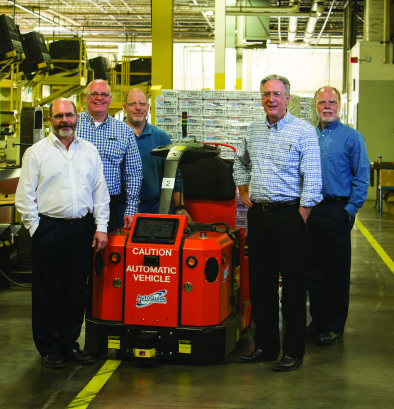Using AGVs at LEDVANCE
The lighting manufacturer reaped savings by reducing maintenance costs and product damage, and using labor more productively. The bottom line: A two-year ROI.
Global manufacturers that want to remain competitive are under constant pressure to reduce operating costs, become more efficient and get more than ever out of their existing facilities. Even lean operations must look for ways to drive continuous improvement and get leaner.
That was certainly the case when LEDVANCE, the manufacturer of traditional and LED lighting products formerly known as OSRAM SYLVANIA, decided to install automatic guided vehicles (AutoGuide) and specially designed, conveyor-topped carts in its 800,000-square-foot facility in Versailles, Ky. The automatic guided vehicles (AGVs) are used in place of lift trucks to move empty pallets to the packaging line and palletized finished goods to a storage area. Loading and unloading pallets has also been automated.
“As we look to stay viable and sustainable, we need to be as competitive as we can,” says plant manager Mike McNulty. “When we looked at where we were incurring costs, we found that we had some fork truck drivers who were doing little more than making a milk run, which was not the most value-added activity for those drivers.”
The result, says McNulty, is that four fork truck driver positions have been re-assigned to more meaningful work within the plant while congestion on the facility floor has been reduced. In addition, LEDVANCE is saving about $8,000 a year in maintenance on fork trucks that are no longer needed and has seen a reduction in product damage due to driver error. “The project will earn a return on investment in just two years,” says McNulty.
Choosing AGVs
LEDVANCE is a world leader in innovative lighting products as well as intelligent and connected lighting solutions for the smart home for consumers and professionals alike. The new company began to operate as a stand-alone subsidiary last summer, still going to market under the SYLVANIA brand in the United States and Canada.
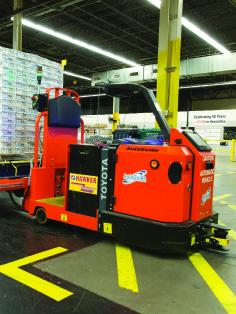
The company has been producing lighting products at the Kentucky plant since 1964, and today it produces an estimated 500,000 lamps per day. A highly automated facility, McNulty says the overall lighting industry has gone through a great deal of transformation over the last five years. “There has been a great deal of emphasis on energy savings and a shift to new technologies, like LED products that are greener for the environment,” he says. “We have to produce products that meet those needs.”
As a global industry, there is excess manufacturing in the marketplace, which puts pressure on plants to be as efficient as possible to remain viable, sustainable and competitive. To that end, McNulty’s plant undertakes an annual “hoshin kanri” event, defined as a “comprehensive step-by-step planning process that takes a systems approach to change toward continuous improvement.”
During the event, McNulty’s team does value stream mapping and time studies and then drills down into areas that offer an opportunity for improvement. The goal, McNulty explains, is to make sure that the entire organization is aligned from a goals and objectives viewpoint.
The AGV project came out of an hoshin kanri exercise held in late 2013. The goal was cost savings. The opportunity was the recognition that the movements of empty pallets to the production lines and finished goods from production to the warehouse were repeatable processes that added no value to the product and had the potential for automation. What’s more, as a result of retirements within the facility, there was an opportunity to fill those more valuable positions with the lift truck drivers who were currently moving pallets. 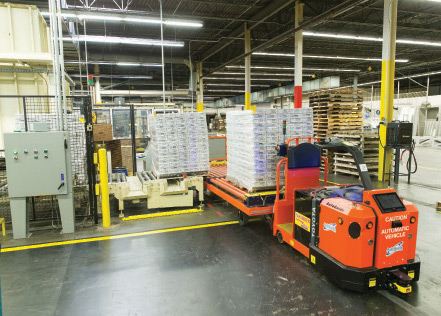
A cross-functional team was put together that included representatives from manufacturing, safety and finance and the facility’s “operational excellence” manager, LEDVANCE’s term for lean. As they evaluated the project, other potential benefits emerged. Despite the size of the facility, space is still at a premium. Moreover, McNulty says that there was often congestion as multiple fork trucks went through the opening between the production and finished goods storage areas, increasing the possibility of an accident or product damage. “We wanted to reduce the amount of fork truck traffic going between the two areas,” he says.
A number of AGV vendors were brought in to compete for the project. They represented a variety of guidance technologies, including wire-guided AGVs, camera-based spatial systems and magnetic tape. As part of the decision-making process, McNulty says his team developed a matrix of important attributes, including warranty, cost of the system, reliability and whether LEDVANCE could make some of the components itself. In the end, they chose a solution using a magnetic tape guidance system and a traffic control software solution that integrates with the PLC at the end of the production line. That ensured that the AGV control software wouldn’t interfere with the factories wireless system.
“We like the idea of spatial systems, but at the time we didn’t think they had the install base that goes with a proven track record,” McNulty says, “and we didn’t want to put wire in the floor because our operations do change. Magnetic tape had the right balance between a proven track record and flexibility.”
The solution also included a custom-designed cart with motorized conveyor that can dock with the facilities existing conveyor system and accommodate two standard 48 x 40-inch pallets or one over-sized pallet designed for 8-foot long fluorescent lamps.
Change management
Selecting a solution was half of the challenge. The other half was presenting the project to employees who would be working with the automation. “As a lean plant, we want employee engagement,” McNulty says. “You don’t want them to feel that automation is a threat to their jobs, and you want them to have a voice in the process.”
The first step was to present the concept to the lift truck drivers so they understood the intent and scope of the project and had an opportunity to voice their concerns. Large scale drawings of the proposed routes were displayed so that workers understood what was going to take place, including an area that allowed them to write comments and concerns. Viable concerns and suggestions were presented to the solution provider during the design process. Updates on the project were included in McNulty’s quarterly communication meetings. 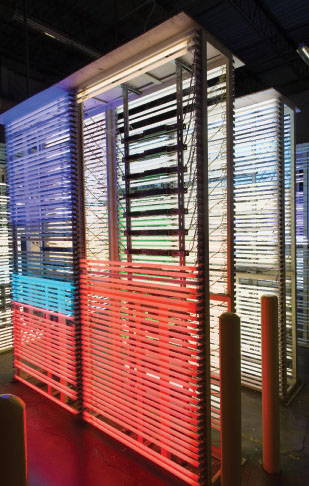
“We were able to alleviate job concerns by having alternative positions available for affected drivers if they chose to stay with the company,” McNulty says. Finally, it was important that employees had some sense of the financial scope of the project, which was modest in the overall scheme of a manufacturing plant. “We didn’t want people to think that we were spending millions of dollars that could be spent on something else,” he says. “This was a fraction of that cost and had a positive economic impact in a reasonable time frame.”
From the start of the hoshin kanri to the go live in the fall of 2014 was about nine months. While some drivers chose to retire, others took the opportunity to move within the plant. The input from the cross-functional team led to a successful startup.
Moving pallets
At present, the process includes two automatic tuggers pulling the custom conveyor-top carts. When two standard pallets, or one over-sized pallet, are ready for storage, an operator at the line presses a call button to initiate pick up. The next available AGV gets a signal to follow a prescribed route
The vehicle control system also checks whether the pallet hopper is full or needs to be replenished with empties. In the production area, pallets ready for the warehouse are automatically loaded onto the cart, which transports them to an accumulation conveyor in the warehouse. There, the cart docks with the accumulation conveyor and automatically discharges the pallets from the motorized conveyor on the cart. The vehicle then docks at an automatic battery charger for an opportunity charge until its next call for service. 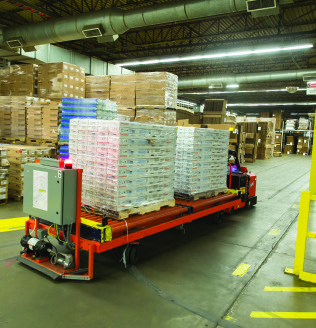
After nearly 18 months of operation, McNulty says the vehicles have been efficient and reliable. The biggest thing they learned, he says, is that there were more operational scenarios than they had originally anticipated. “If we were doing this again, we’d try to identify more of those in advance so that we could have programmed them in before going live rather than after,” he says. Indeed, he adds, they have plans to add AGVs to other operational areas in the plant. And, while magnetic tape is sufficient to its current needs, LEDVANCE is beta testing other guidance systems for the future. “As we move forward, the tugger isn’t going to change, but we recognize that the software, guidance systems and controls are evolving,” he says.
The project has delivered the cost savings anticipated, including a two-year ROI. More importantly, it has been embraced by operational employees, who understand that the plant has to remain competitive to remain open. “We also demonstrated to senior management that we’re capable of taking on these kinds of semi-complex solutions,” McNulty says. “It’s been a good investment.”


